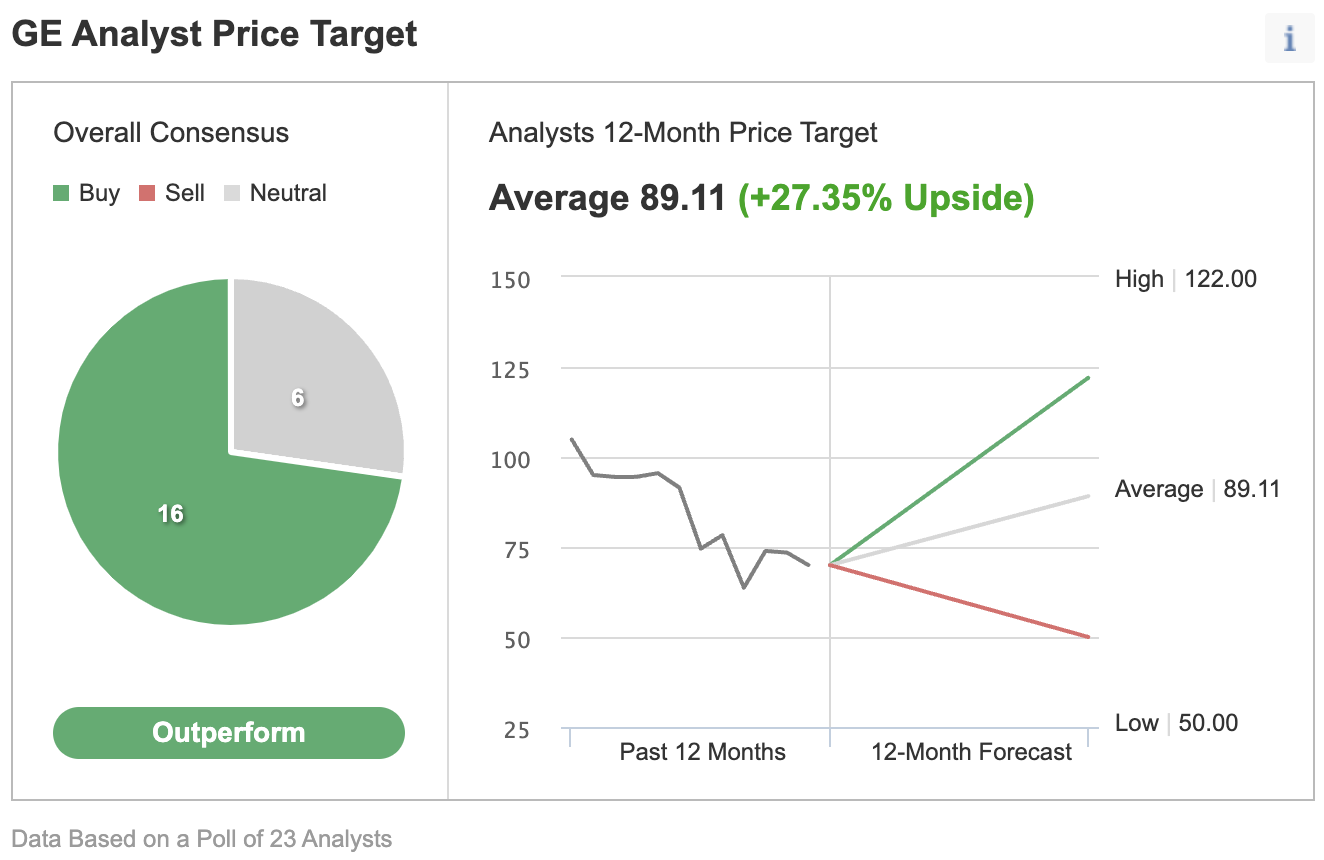- GE plans to split into three separate public companies over the next two years as part of its bid to unlock value
- The breakup represents a good buying opportunity now that the company has improved its balance sheet and made its structure simple
- The majority of Wall Street analysts are bullish on GE’s outlook
It’s difficult to make a bullish case for General Electric (NYSE:GE) as the 130-year-old industrial conglomerate remains in the middle of a deep restructuring process after spectacularly falling from grace during the past decade.
Chief Executive Officer Larry Culp took over the company in 2018 to save the sinking ship that GE had become after many years of financial mismanagement.
His already-tough mission has become even more challenging this year. On top of all internal problems, GE is struggling with inflation, supply-chain disruptions, and COVID-related restrictions in China. 
To battle those difficulties, the Boston conglomerate plans to split into three public companies over the next two years, encompassing its healthcare, aviation, and energy businesses.
GE’s healthcare business will be the first to spin off in January 2023. It will be followed by its renewable energy, fossil fuel power, and digital units, which will combine into a single, energy-focused entity in 2024. The third company will comprise GE Aviation, the company’s jet-engine division.
Culp, approaching his fourth anniversary of taking over as CEO, has overhauled manufacturing practices, sold off divisions, paid down debt, and made GE’s far-flung divisions responsible for covering their costs.
As the company approaches its first significant milestone in the turnaround process, some signs show that Culp and his team are succeeding in their bid to instill some life into GE.
Momentum In Aviation Business
In its latest earnings report, GE easily beat Wall Street’s expectations after it reported surprise positive cash flow, fueled by the jet-engine division, where sales jumped 27%. That helped push the parent company’s profit to $0.78 a share, against the $0.37 average of analysts’ estimates.
The shares of the Boston-based group have outperformed the benchmark S&P 500 Index during the past two months, with many analysts recommending buying the stock to benefit ahead of the company’s breakup.
Resurgence in the company’s aerospace business and the progress in its turnaround are the two major factors keeping analysts bullish on this industrial name despite the challenging macroeconomic environment.
In an Investing.com survey of 23 analysts, 70% have a buying rating on the stock, with their consensus 12-month price target implying a 27.3% upside potential. 
Source: Investing.com
Goldman Sachs praised the company’s management in its recent note, saying GE’s healthcare and aviation divisions are picking up steam:
“We remain buy-rated, as we think GE has attractive longer-cycle exposure and believe valuation is not reflecting the progress GE has made to become a fundamentally strong company.”
New Catalyst
Wolfe also reiterated GE as outperform in a recent note, saying the wind production tax credit in President Biden’s Inflation Reduction Act should serve as a catalyst for GE shares. GE Renewable Energy business has been under pressure this year as some onshore wind customers in the U.S., where GE is the largest supplier, paused orders following the expiration of a key U.S. tax credit.
Wolfe’s note adds:
“This is why the restoration of the production tax credit in the Inflation Reduction Act, with project visibility over the next 10 years, is such an important catalyst for recovery.”
Value investor Mason Hawkins, who held 3.28 million shares of GE by the end of Q2, said that the market is not giving GE credit for the material improvements CEO Larry Culp has made in his tenure.
“The balance sheet today is stronger than it has been in a very long time, and each of the three primary business segments each has strong paths to increasing earnings, regardless of the economic environment.”
Hawkins added that:
“Healthcare has historically not been a cyclical business. While Aviation typically has some economic sensitivity, the business still has a strong COVID rebound tailwind that should continue even in an uncertain environment. Power is a less cyclical business, and GE maintains a steady business servicing approximately one-third of the world’s electricity.”
Bottom Line
GE stock may not show much positive near-term momentum as the macroeconomic environment becomes hostile for industrial companies. But for long-term investors, GE’s breakup represents a good buying opportunity now that the company has settled on a plan to take advantage of its leading market position, especially in healthcare and aviation.
In my view, for investors with a high-risk appetite, building up a position in GE stock with a three-to-five-year horizon could prove to be a productive move.
Disclosure: The writer doesn’t own GE shares.
